Winner of 2001 Wilk Essay Prize for Research in Polish Music (Student Category ex aequo)
by Sławomir Dobrzański
Abstract
The article (awarded the 2001 Wilk Prize in Student Category ex aequo with Grochowska) provides a summary of historical research on possible personal contacts between Frederic Chopin (1810-1849) and Maria Szymanowska (1789-1831). Although there is no direct evidence of an actual meeting between them, several documents and historical circumstances suggest that both composers must have known each other personally.
The main body of the article is devoted to a comparative analysis of musical styles of both the composers and to the possible influence of Szymanowska’s compositions on Chopin’s musical language. Although some of the research is based on previous insights of musicologists such as Maria Iwanejko and George Golos, the author suggests some new possible comparisons. Especially noteworthy is a brief analysis of the melodic material in Polonaises by Oginski, Szymanowska, and earliest Polonaises by Chopin. Szymanowska’s works discussed in the text include Vingt Exercises et Preludes, Waltzes, Songs, Mazurkas, dances, and 2 Nocturnes
Article
During the second decade of the nineteenth century, when Szymanowska toured Europe and enjoyed international fame, Fryderyk Chopin, twenty-one years her junior, was a student at the Warsaw Lyceum and then at the Warsaw Conservatory. It seems quite obvious that they must have known each other. It is certain that Chopin was planning to attend Szymanowska’s concert in Warsaw in January 1827. In his letter to Jan Białobłocki, dated January 8, 1827, Chopin wrote: “Mrs. Szymanowska gives a concert this week. It is to be on Friday, and the prices have been raised; they say the parterre is to be half a ducat, the stalls a ducat, and so on. I shall be there for sure, and will tell you about the reception and playing.”[1]There is, however, no confirmation of his presence there, especially since the date of the concert was suddenly changed.[2]Undoubtedly, there were also several other occasions for Chopin and Szymanowska to hear each other play, but, because they both resided with their families in Warsaw, no trace of any such event found its way into their correspondence.
Teofil Syga and Stanisław Szenic assume that Szymanowska was a member of the Society of Good Deeds Committee, the organizer of Chopin’s February 1818 concert in which he performed the Piano Concerto by Adalbert Gyrovetz.[3]Apart from official concerts, both artists frequently performed at private salons, yet another venue where they could meet. Given Szymanowska’s established name and the young Chopin’s growing reputation, they must certainly have been interested in each other’s work. Józef Elsner, Chopin’s composition teacher, had been a close friend of Szymanowska’s parents, and he almost certainly was also Szymanowska’s private tutor. His letter to Chopin, dated November 1831, criticized some of Szymanowska’s performance manners:[4]
Mrs. Szymanowska (…) giving a concert here, handed out red pencils at a rehearsal to cross out some measures here and there in Hummel’s Concerto in B Minor, even though she had already shortened the work before. Meanwhile, in the middle of some Variations, I don’t recall the composer, she inserted an Andante by Field. This is a great abuse! We had no choice but to simply listen to Mrs. Szymanowska and just admire her fingers.
Szymanowska’s name is mentioned in Chopin’s correspondence once again, in a letter addressed to him by his sister Ludwika Chopin. Quite jokingly, Ludwika informed her brother that Szymanowska used to call Kalkbrenner un filou.[5]Both Elsner’s and Ludwika Chopin’s letters, written after Szymanowska’s death, suggest that she was a frequent subject of conversation in Chopin’s circles.
Virtually all of Szymanowska’s important published works were available at the time of Chopin’s childhood and adolescence, including the Vingt Exercises et Preludes [Twenty Exercises and Preludes] (1820) and 24 Mazurkas (1825). It is almost certain that Chopin owned these works in his private piano music collection, although he never mentioned them in his correspondence.[6]In fact, he never discussed Szymanowska’s music in any of his preserved letters. Polish musicologists note that it is somewhat peculiar that Chopin generally did not discuss contemporary Polish music in his correspondence. It is an established historical fact, however, that he knew the song collection Śpiewy historyczne [Historical Songs], which was published in 1816 and to which Szymanowska contributed three compositions. These songs were regularly performed at a hostel for young students in Warsaw owned by Chopin’s father Nicolas, and in Chopin’s house.[7]
Mieczysław Tomaszewski writes: “It is puzzling that literally all the musical genres that she used were soon to become Chopin’s genres. She composed mazurkas, polonaises and waltzes, etudes, preludes and nocturnes, romances, dumy and dumki. Her output strongly invites comparisons.”[8]A comparison of Szymanowska’s and Chopin’s music must consider three distinct elements: parallels in musical language, Szymanowska’s influence on the younger composer, and, in one significant instance, similar results in artistic development. The parallels in style between some of Szymanowska’s and Chopin’s works can be best seen in their miniatures, which constitute their contribution to salon music. For Szymanowska this music was simply part of her natural environment; for Chopin it was first part of his education. Later in his life, he wrote such music only as occasional pieces for relatives and close friends.
Chopin’s Ecossaise in D Major Op. 72 No. 3 (composed in 1827)[9]and Szymanowska’s Anglaise in E-flat Major from the collection Eighteen Dances (published around 1820) show an incredible similarity of style. Both compositions are based on a very similar melodic and rhythmic motive in the right-hand part, which is supported by a steady eighth-note accompaniment in the left-hand part. Szymanowska utilizes a smaller range of keys and a simpler accompaniment than Chopin, which makes her composition more accessible to amateur pianists. Chopin’s Ecossaise is rather more complex musically – he employs a characteristic augmented chord in measure no. 3, and enriches the accompaniment part with chords. Yet the impression from first hearing them is that both compositions may have been written by the same composer (see Figure 1 and Figure 2).

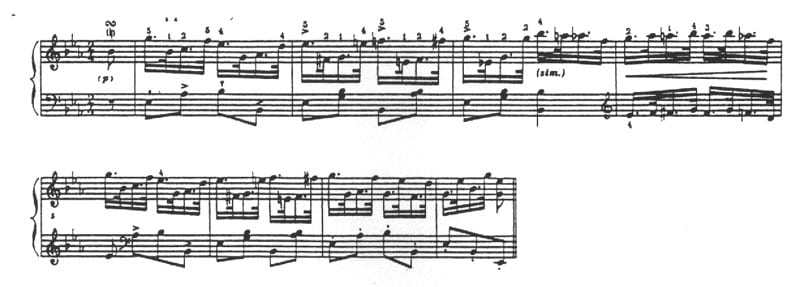
Further parallelism in the musical language of the two composers is found in their songs for voice and piano. Szymanowska and Chopin were rooted in the same Polish tradition of songwriting, which originated from simple arrangements of arias and ariettas in popular theatrical plays and operas. The structure of Szymanowska’s strophic ballade Świtezianka[Water Sprite] (published in 1828 in Moscow,[10] (see Figure 3) and Chopin’s strophic song Śliczny chłopiec [A Handsome Lad] Op. 74, No. 8 (see Figure 4), which he sent to his sister Ludwika in 1844,[11] comes from the operatic tradition of closing each strophe with a short ritornello, musically not related to the main content of the piece.[12]
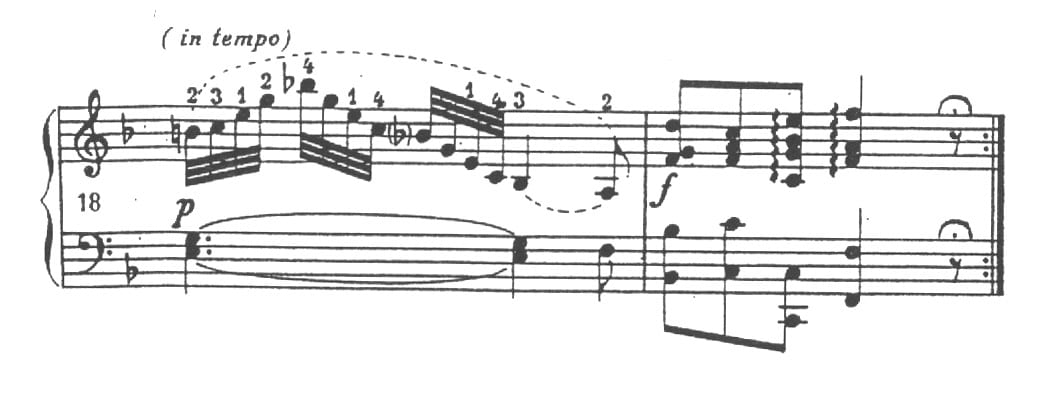

Both Szymanowska and Chopin wrote dances for practical performance. Chopin’s compositional output contains eleven waltzes intended for such use;[13] Szymanowska’s four waltzes from the collection Eighteen Dances also fall into this category.[14] Again, the musical styles of both composers show a striking similarity here. At one instance, the melodic material they explore seems to be particularly related. The repeated, regular flow of a descending sixteenth-note melodic pattern in Chopin’s Waltz in A-flat Major Op. posthume (see Figure 5) and in Szymanowska’s Waltz in F Major No. 3 from the collection Eighteen Dances (see Figure 6) represents a possible influence on both composers’ musical language of the Polish folk dance known as the “windmill” or “whirlpool” Oberek, a close but temporally much faster relative of the Mazur. This striking similarity of both dances was first noted by Maria Iwanejko.[15]

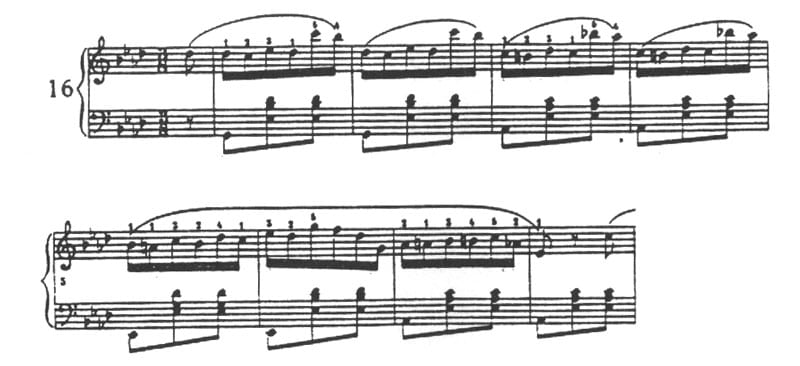
Both Szymanowska and Chopin were influenced by the popular composer of piano polonaises, Prince Michał Kleofas Ogiński (1764-1833). There is a striking resemblance in the shape of opening motives (and specifically the use of upper and lower neighbor-tones) between Ogiński’s Polonaise Les Adieux a la Patrie (see Figure 7), Szymanowska’s Polonaise in F Minor (ca. 1820; see Figure 8), her Dance Polonaise (1824; (see Figure 9), and Chopin’s early Polonaise in B-flat Major (see Figure 10), which Chopin wrote when he was just seven years old.
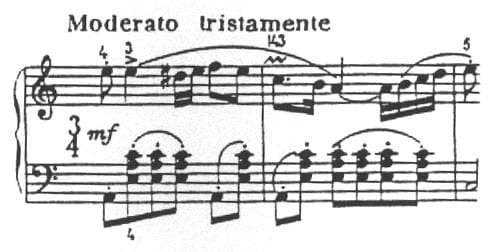

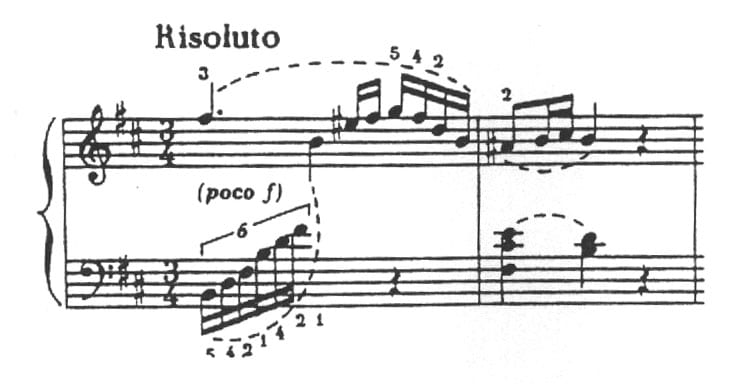
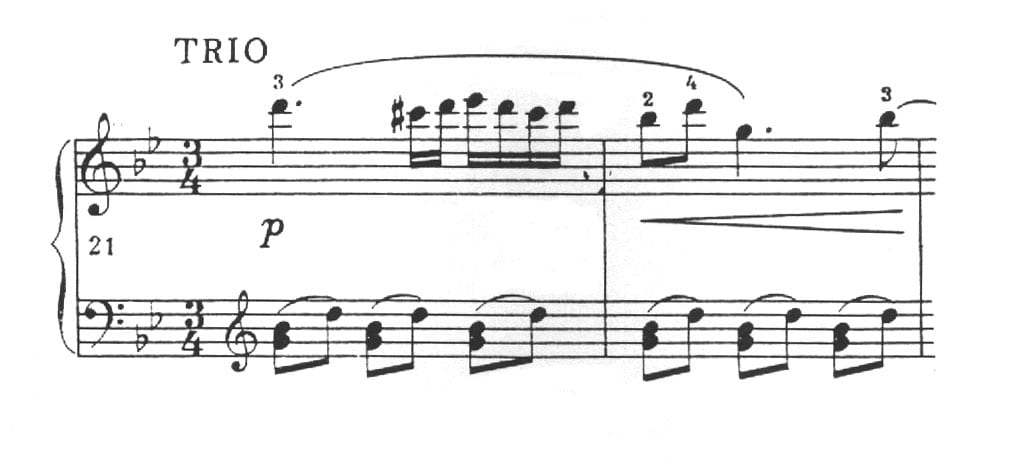
It seems that Chopin, whose musical vocabulary in polonaises was much more advanced than that of both Ogiński and Szymanowska, was very familiar with the polonaise style developed by Ogiński and his followers. In Chopin’s mature Polonaise-Fantasy Op. 61, which was published in 1846,[16] the composer included a similar melodic statement, which this time serves as an artistic means to recall the Polish history from the times of Napoleonic Wars and the early Kingdom of Poland (see Figure 11).

In view of the above examples, the parallelism or overlapping of musical styles of both composers seems rather obvious. It is, however, important to remember that for Szymanowska works such as little dances and songs played an important role in her career, whereas for Chopin works of that kind were either preparatory exercises written before the development of his truly individual style, or else little gifts for family and friends composed with no real artistic intentions.
Szymanowska’s collection Vingt Exercises et Preludes [Twenty Exercises and Preludes], published ca. 1820, seems to have had a direct influence on Chopin’s mature style. It was the first set of etudes and preludes written by a Polish composer.[17] Each work of the set has a well-conceived original musical idea and deals with one distinct aspect of piano technique. The collection as a whole shows a certain resemblance to Chopin’s Op. 10, Op. 25, and Op. 28, which in this above-mentioned aspect were composed with similar artistic intentions. Musicologists Maria Iwanejko in Poland (1959) and George Golos in the United States (1960) were probably the first ones to analyze the influence of Szymanowska’s Etudes on the musical language of Chopin. Many, but not all of the following examples come from their original research.
Szymanowska’s Etude in F Major No. 3 (see Figure 12), shows a striking similarity to Chopin’s Prelude in the same key, Op. 28 No. 23 (see Figure 13). Both pieces are based on an even flow of sixteenth-note broken chord figurations in the right hand part, over chordal accompaniment of the left hand.


The upbeat eighth-note beginning of Szymanowska’s Etude in F Major, as well as the key shift to D Minor in measure 9, bear a certain similarity to Chopin’s Etude Op. 10 No. 8 , which also starts with an upbeat on the same note C and shifts to D minor in meas. 29 (see Figure 14). Also similar is the spacing between the right and left hand parts.[18]

The texture of Szymanowska’s Etude in C Major No. 15 (see Figure 17), and of her nocturne Le Murmure in A-flat Major (see Figure 15) may have inspired Chopin’s later (1835) Etude in A-flat Major, Op. 25 No. 10 (see Figure 16).[19] The texture of these compositions is based on broken chord patterns filling the space between the soprano melodic line and the harmonic bass notes.

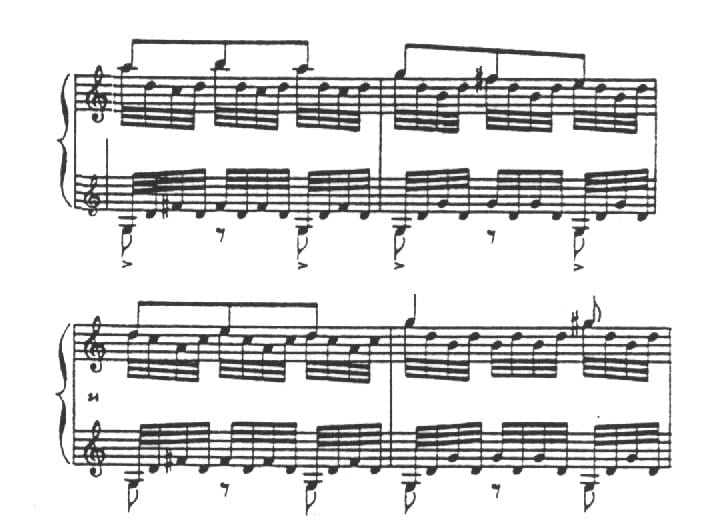

Similarly, the texture of the fourth variation of Chopin’s Variations on La ci darem la mano from Mozart’s Don Giovanni ((see Figure 19). seems to have originated from Szymanowska’s Etude in E-flat Major No. 12 (see Figure 18).[20] In these compositions, both composers use pianistically challenging, wide staccato leaps in the left and right hand parts. Chopin’s Variations were written in 1827 as an assignment for his composition class with Józef Elsner; one could easily assume that Elsner mentioned Szymanowska’s piano texture to his student. Later in life, Chopin utilized a similar kind of texture in his Etude in A Minor, Op. 25 No. 4 (see Figure 20). Interestingly, the melody line in Szymanowska’s work falls on the strong beats of the measure, while in both examples by Chopin, the melody line appears on the weak beats, giving the music more lightness and energy (Szymanowska used such technique in a brief passage by the end of her Etude). Also noteworthy is Szymanowska’s striking opening chord:



Maria Iwanejko points out the very interesting idea of ending a piece with a trill on the fifth degree of the scale (the root of the dominant chord), resolving on the Tonic chord. Such an ending appears in Szymanowska’s Etude in E Major No. 18 and in Chopin’s Etude in A-flat Major Op. 25 No. 1.[21] Another example of an ending formula that was used by both composers is seen in the final measures of Szymanowska’s Etude in D Minor No. 14 (see Figure 22)[22] and in the conclusion of the third movement of Chopin’s Concerto in F Minor Op. 21 (composed in 1827; see Figure 21).[23] Both passages use chromatically enriched D Minor and F Major chords; Chopin’s rendition is more elaborate, reinforcing the F Major triad pitches through their repetition.[24]


The melodic and textural design of Szymanowska’s Etude in D Major, No. 3 (see Figure 23) is closely related to Chopin’s Etude in C Major Op. 10 No. 7 (see Figure 24), and Etude in D-flat Major, Op. 25 No. 8 (see Figure 25).[25]



In examining Szymanowska’s output for piano, it is apparent that she was not as skillful at writing accompaniments or “left-hand” parts as she was in dealing with the material intended for the right hand. However, in a few instances, her accompaniments show considerable inventiveness. Interestingly, one can find echoes of her accompaniments or “left-hand” parts as she was in dealing with the material intended for the right hand. However, in a few instances, her accompaniments show considerable inventiveness. Interestingly, one can find echoes of her accompaniments in some of Chopin’s works. The rhythmic formula in the tenor range, so frequently repeated in Szymanowska’s Etude No. 8 in E-flat Major (see Figure 26 or its larger image), plays a similar role in Chopin’s Etude Op. 10 No. 8 in F Major (see Figure 27 or its larger image).

Figure 26: Maria Szymanowska. Etude No. 8 in E-flat Major, mm. 1-2.
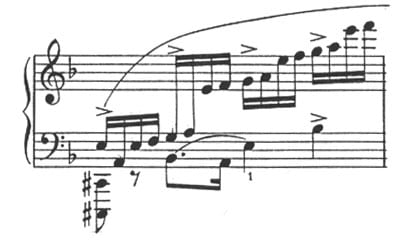
Figure 27: Fryderyk Chopin, Etude Op. 10 No. 8 in F Major, m. 32.
In Szymanowska’s Etude in D Minor No. 14, the left-hand accompaniment is enriched by a trill on a single note, reinforcing the sonority which is about to be resolved (see Figure 28 or its larger image). A single-note trill of this kind can be found in the first movement of Chopin’s Concerto in E Minor (1833; see Figure 29 or its larger image), and in his Prelude in F Major, Op. 28 No. 23 (cf. Figure 6).
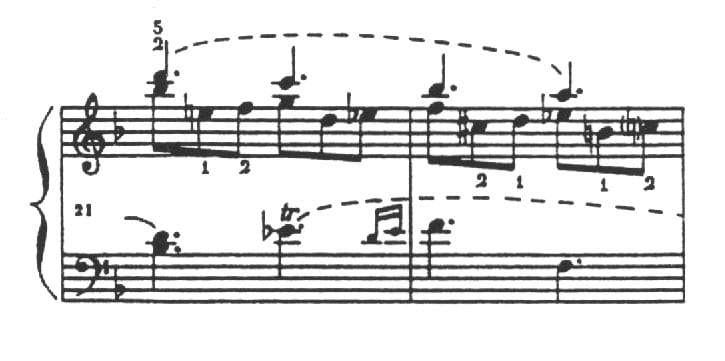
Figure 28: Maria Szymanowska, Etude in D Minor No. 14, mm. 29-30.

Figure 29: Fryderyk Chopin, Concerto in E Minor Op. 11, first movement, m. 622.
Taking into consideration the above-mentioned instances, the influence of Szymanowska’s Twenty Exercises and Preludes on Chopin’s musical language seems rather obvious. One would thus be tempted to expect that her Twenty-four Mazurkas, published in 1825, would have had a similar impact on Chopin’s work. Surprisingly, the two composers have little in common when one examines their mazurkas. Szymanowska’s collection was the largest set of mazurkas composed to date, but they are probably composed for dancing. Her mazurkas are all in three-eighth meter, while all of Chopin’s works in the genre are in three-quarter meter. Also, Szymanowska’s mazurkas do not have introductions, which several of Chopin’s mazurkas do. Szymanowska’s mazurkas are very short and grounded in the basic sonorities of the major-minor tonal system (all her mazurkas are in major keys), while those of Chopin are frequently lengthy and contain a variety of harmonic experiments with church modes, local folk music scales, and chromaticism. At the time when Szymanowska composed her mazurkas, stylization meant simplification. It was exactly the opposite of Chopin’s achievement; he was the first composer to discover the richness of Polish folk music and successfully apply it to classical music. Any resemblance between Szymanowska’s and Chopin’s mazurkas can be seen only in instances in which Chopin intentionally simplifies the texture of his music (see Figure 30 or its larger image and Figure 31 or its larger image).

Figure 30: Maria Szymanowska, Mazurka No. 21, mm. 1-4.

Figure 31: Fryderyk Chopin, Mazurka Op. 7 No. 5, mm. 5-8.
While previous examples showed parallelism in musical style, as well as the possible influence of Szymanowska’s works on Chopin’s creative genius, it seems in one instance that both artists independently achieved similar results when dealing with the nocturne genre. Szymanowska’s late Nocturne in B-flat, published in 1852 after the composer’s death,[26] is based on a variation technique, which can also be found in Chopin’s Nocturne Op. 9 No. 2 and in his Berceuse Op. 47. George Golos writes:[27]
Here she approaches the spirit of Chopin’s nocturnes (cf. Op. 32, No. 2) and even ballades so closely that one begins to wonder if at this point it is not a matter of Chopin’s influence on Szymanowska, rather than vice versa, but such a possibility is quite unlikely since she spent her last years away from Warsaw, at a time when Chopin was just starting on his career and very few compositions of his had appeared in print.
Texturally, Szymanowska’s Nocturne in B-flat shows striking similarity with Chopin’s Nocturne Op. 32 No. 2 (see Figure 32 or its larger image and Figure 33 or its larger image).[28]
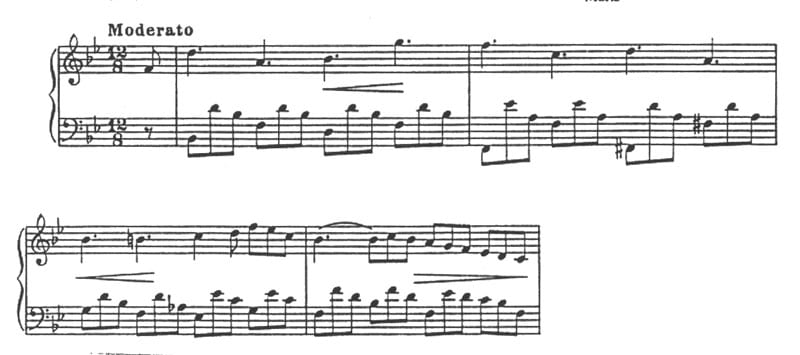
Figure 32: Maria Szymanowska, Nocturne in B-flat Major, mm. 1-4.

Figure 33: Fryderyk Chopin, Nocturne in A-flat Major Op. 32 No. 2, mm. 1-6.
Interestingly, after presenting main melodic ideas in their nocturnes, both composers achieve the effect of contrast by using a fuller, chordal texture, with two harmonies per measure (see Figure 34 or its larger image and Figure 35 or its larger image).

Figure 34: Maria Szymanowska, Nocturne in B-flat Major, mm. 17-19.

Figure 35: Fryderyk Chopin, Nocturne in A-flat Major, Op. 32 No. 2, mm. 27-28.
A striking melodic and harmonic similarity between Szymanowska’s ballade Świtezianka, written in 1827 for Adam Mickiewicz’s poem of the same name,[29] and Chopin’s Ballade No. 2 in F Major composed in 1836,[30] suggests another possible influence of Szymanowska’s work on Chopin. Both Chopin and Mickiewicz resided in Paris. On several occasions Chopin met the poet and probably his wife Celina, Szymanowska’s daughter, at meetings of Polish expatriates.[31] Given the popularity of Mickiewicz’ Świtezianka, it is very possible that Chopin was also familiar with Szymanowska’s music written for that text.
In his impressive study on Fryderyk Chopin, Mieczysław Tomaszewski concludes his discussion about Szymanowska’s influence on Chopin’s music with the following:[32]
They [the comparisons between Szymanowska and Chopin] are usually crushing for her, but at the same time splendidly exhibit Chopin’s starting point. They also let us see clearly the difference between an average talent and a genius – especially that both composers use the same, identical repertoire of idioms of the musical language of the time.
Tomaszewski’s statement does not seem to do enough justice to Szymanowska. One must remember that, while being “the most important personality” among “the Slavic predecessors of Chopin,”[33] she never studied composition professionally. And yet, her compositions seem to have influenced Chopin more than any other music written “professionally” by other Polish composers of the time. It seems rather obvious that Szymanowska was not “an average talent.”
The influence of Szymanowska’s musical ideas on Chopin’s output is absolutely undeniable; nevertheless, if we restrict our consideration merely to “historically confirmed” facts and documents, Szymanowska’s connection with the younger composer seems rather tenuous. Meanwhile, in the century-and-a-half since Chopin’s death, researchers have uncovered considerable evidence suggesting the influence on Chopin not only of Szymanowska, but also of numerous other composers, including Johann Ladislav Dussek, Johann Nepomuk Hummel, Vincenzo Bellini, John Field, and so on. And as Chopin is himself suspiciously silent about the influence of other composers on his music, the entire issue becomes a rather curious episode in the history of music. Perhaps future musicologists will have to confront the following question: is it possible that Chopin consciously chose not to publicly acknowledge Szymanowska’s and others’ influence on his musical language?
NOTES
[1]. Chopin’s Letters, collected by Henryk Opieński, transl. E.L.Voynick, (New York: Alfred A Knopf, Inc., 1931), p. 34. [Back]
[2]. Stanisław Szenic, Teofil Syga. Maria Szymanowska i jej czasy [Maria Szymanowska and her Times], (Warsaw: PIW, 1960), p. 327. [Back]
[3]. Syga, Szenic, op. cit., p. 86. [Back]
[4]. Syga, Szenic, op. cit., p. 346. [Back]
[5]. Igor Belza, Maria Szymanowska (Kraków: PWM, 1987), p. 63. The French word “Filou” means someone who is dishonest, without scruples. [Back]
[6]. Stefania Łobaczewska, ed. Z dziejów polskiej kultury muzycznej [From the History of Polish Musical Culture], (Kraków: PWM, 1966), vol. 2, p. 157. [Back]
[7]. Mieczysław Tomaszewski, Chopin: Człowiek, Dzieło, Rezonans (Poznań: Podsiedlik, 1998), p. 25. [Back]
[8]. Tomaszewski, op. cit., p. 588. [Back]
[9]. Tomaszewski, op. cit., p. 369. [Back]
[10]. Belza, op. cit., p. 105. [Back]
[11]. Tomaszewski, op. cit., p. 533. [Back]
[12]. Jerzy Gabryś, Historia Polskiej Pieśni Solowej, op. cit., p. 90. [Back]
[13]. Tomaszewski, op. cit., p. 361. [Back]
[14]. Her waltzes for three hands were probably not intended for dancing. [Back]
[15]. Maria Iwanejko, Maria Szymanowska (Kraków: PWM, 1958), p. 157. [Back]
[16]. Tomaszewski, op. cit., p. 110. [Back]
[17]. Irena Poniatowska, Historia i interpretacja muzyki. Z badań nad muzykš od XVII do XVIII wieku [History and Interpretation of Music. From the Research on Music from the 17th to the 19th Centuries]. (Warsaw: Musica Iagellonica, 1995) p. 95. [Back]
[18]. George [Jerzy] Golos, “Some Slavic Predecessors of Chopin.” The Musical Quarterly 46 (1960): 443. [Back]
[19]. Golos, op. cit., p. 445. [Back]
[20]. Golos, op. cit., p. 444. [Back]
[21]. Iwanejko, op. cit., p. 106. [Back]
[22]. Researchers frequently associate this Etude with Chopin’s op. 10 No.2. Golos, op. cit., p. 443. [Back]
[23]. Tomaszewski, op. cit., p. 41. [Back]
[24]. Similar concept of an ending appears in Chopin’s Etude op. 10 No. 8 [Back]
[25]. Iwanejko, op. cit., p. 106. [Back]
[26]. Belza, op. cit., p. 172. Maria Iwanejko provided an in-depth analysis of the Nocturne. Iwanejko, op. cit., pp. 168-179. [Back]
[27]. Golos, op. cit., p. 446. [Back]
[28]. Regina Smendzianka, Jak grać Chopina – próba odpowiedzi [How to Play Chopin – an Attempt to Provide an Answer] (Warsaw: Fundacja im. Chopina, 2000), p. 89. [Back]
[29]. Belza, op. cit., p. 105. Belza also noticed that particular resemblance between Chopin and Szymanowska. Belza, op. cit., p. 159. [Back]
[30]. Tomaszewski, op. cit., p. 74. [Back]
[31]. Tomaszewski, op. cit., pp. 61, 69,73. [Back]
[32]. Tomaszewski, op. cit., p. 588. [Back]
[33]. Golos, op. cit., p. 443. [Back]